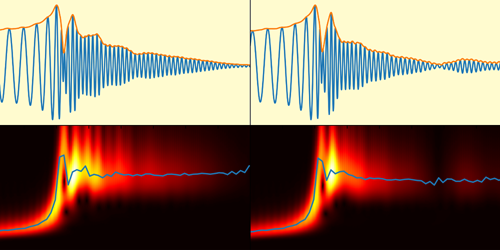Listening to Equation-of-State Changes
In matter at densities of around one trillion kilograms per cubic centimeter, researchers predict that quarks can be liberated from subatomic particles. Such quark matter is thought to have existed in the first tens of microseconds of the universe and might form in some neutron stars and in the products of their mergers. But this long-postulated, quirky state of matter has yet to be observed. Now Yong-Jia Huang of the Chinese Academy of Science and his colleagues predict that its signature could be detected in the postmerger gravitational waves of coalescing neutron stars [1]. Experimental detection of quark matter would help physicists hone models of these fundamental particles.
The team simulated mergers between two neutron stars made of hadrons—subatomic particles containing bound quarks. They then calculated the properties of the gravitational waves emitted during mergers that left the system hadronic and mergers that transformed it into quark matter.
They found that, for some scenarios, the merger induced a sudden decrease in the gravitational-wave frequency, with the exact decrease depending on the equation of state used to model the quarks. Specifically, they found that some postmerger quark systems—systems that underwent a “crossover” transition—emitted lower-frequency gravitational waves than systems that remained hadronic. They also found that some postmerger quark systems were less compact than hadronic ones, as they underwent a stiffening process involving a release of pressure as the particles changed.
While the frequency of all the simulated postmerger waves is too high to detect with current gravitational-wave detectors, next-generation detectors could spot the signals, helping to constrain theories of quark dynamics. “Nobody knows what happens during a hadron-quark phase transition,” Huang says. “We show a way to study that.”
–Katherine Wright
Katherine Wright is the Deputy Editor of Physics Magazine.
References
- Y. J. Huang et al., “Merger and postmerger of binary neutron stars with a quark-hadron crossover equation of state,” Phys. Rev. Lett. 129, 181101 (2022).




